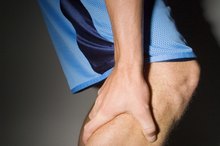Complications After Hammer Toe Surgery
Hammer toe is a deformity of the toe, in which one or both joints bend abnormally into a "C" shape 1. Hammer toe can develop in any of the lesser toes, but most often affects the second toe, according to the Merck Manuals 1. Hammer toes can become painful over time, as the joints lose flexibility. It is also possible for a corn to develop over the prominent joint. When a hammer toe becomes problematic, surgery can be performed to remove part of the bone and release the contracted tendon.
If you are experiencing serious medical symptoms, seek emergency treatment immediately.
Pain and Swelling
Hammer toe surgery requires the cutting of skin, nerves, tendon and bone, and as such, pain and swelling are not unexpected following the surgery, according to Premier Podiatry. Pain can be controlled through the use of pain medications dispensed by the surgeon. Keeping the affected leg and foot elevated can reduce swelling. Ice placed just above the surgical site can help keep swelling to a minimum. Rarely, the pain and swelling can become permanent.
- Hammer toe surgery requires the cutting of skin, nerves, tendon and bone, and as such, pain and swelling are not unexpected following the surgery, according to Premier Podiatry.
- Ice placed just above the surgical site can help keep swelling to a minimum.
Scarring
Complications of ORIF Ankle Surgery
Learn More
After hammer toe surgery heals, it leaves a small scar that becomes less noticeable over time. In some cases, a keloid scar can form. According to MedlinePlus, a keloid is an overgrowth of scar tissue that appears red and inflamed, and possibly painful 2. Keloids are more likely to occur in African Americans. Sometimes, nerve tissue can become trapped, creating a painful scar called an adhesion.
- After hammer toe surgery heals, it leaves a small scar that becomes less noticeable over time.
- In some cases, a keloid scar can form.
Infection
A surgical site creates a wound, so there is the small possibility of developing an infection afterward, according to Premier Podiatry. Infection following hammer toe surgery can usually be handled with a short course of oral antibiotics. In rare cases, the infection can reach the bone, causing a serious infection called osteomyelitis. Osteomyelitis needs to be treated in the hospital with an extended course of intravenous antibiotics, followed by another course of oral antibiotics.
- A surgical site creates a wound, so there is the small possibility of developing an infection afterward, according to Premier Podiatry.
- Osteomyelitis needs to be treated in the hospital with an extended course of intravenous antibiotics, followed by another course of oral antibiotics.
Delayed Healing and Dehiscence
Causes of Chronic Ankle & Foot Pain
Learn More
Before having hammer toe surgery, the surgeon will test the circulation through blood tests and vascular studies, but delayed healing can still occur in some patients, according to FootDoc.ca 3. This happens more often in smokers, diabetics and those with metabolic diseases. In some cases, a wound dehiscence may occur. A wound dehiscence refers to a surgery that does not heal or breaks open after healing. The most common cause of a wound dehiscence is infection.
- Before having hammer toe surgery, the surgeon will test the circulation through blood tests and vascular studies, but delayed healing can still occur in some patients, according to FootDoc.ca 3.
- In some cases, a wound dehiscence may occur.
Recurrence of Deformity and Floating Toe
After having a hammer toe corrected through surgery, there is the chance that the deformity will return 1. According to Podiatry Today, this complication is usually due to the surgeon failing to isolate the exact underlying bio-mechanical cause of the deformity and correct it. There is also the chance of developing a flail toe, one that does not sit flat on the ground. A flail toe sticks up in the air a bit and can be either stiff or floppy. After surgery, it is important to avoid wearing high heels and to get well-fitting shoes that give the toes plenty of room, to lessen the chance for recurrence.
- After having a hammer toe corrected through surgery, there is the chance that the deformity will return 1.
- There is also the chance of developing a flail toe, one that does not sit flat on the ground.
Related Articles
References
Writer Bio
Kathryn Meininger began writing and publishing poetry in 1967. She was co-founder and editor of the professional magazine "Footsteps" and began writing articles online in 2010. She earned a Doctor of Podiatric Medicine from Temple University School of Podiatric Medicine and a Bachelor of Arts in biology from William Paterson University.









